The Phantom of the Opera Blu-ray Movie
HomeThe Phantom of the Opera Blu-ray Movie 
Kino Lorber | 1925 | 1 Movie, 3 Cuts | 93 min | Not rated | Oct 13, 2015
Movie rating
8 | / 10 |
Blu-ray rating
| Users | 0.0 | |
| Reviewer | 4.0 | |
| Overall | 4.0 |
Overview
The Phantom of the Opera (1925)
At the Opera of Paris, a mysterious phantom threatens a famous lyric singer, Carlotta and thus forces her to give up her role (Marguerite in Faust) for unknown Christine Daae. Christine meets this phantom (a masked man) in the catacombs, where he lives. What's his goal ? What's his secret ?
Starring: Lon Chaney, Mary Philbin, Norman Kerry, Arthur Edmund Carewe, Gibson GowlandDirector: Rupert Julian
| Horror | Uncertain |
| Drama | Uncertain |
| Romance | Uncertain |
Specifications
Video
Video codec: MPEG-4 AVC
Video resolution: 1080p
Aspect ratio: 1.29:1
Original aspect ratio: 1.33:1
Audio
English: LPCM 2.0
Subtitles
None
Discs
50GB Blu-ray Disc
Two-disc set (2 BDs)
Playback
Region A (B, C untested)
Review
Rating summary
| Movie | 4.0 | |
| Video | 4.0 | |
| Audio | 3.5 | |
| Extras | 4.0 | |
| Overall | 4.0 |
The Phantom of the Opera Blu-ray Movie Review
If you've seen one 'Phantom', have you indeed seen them all?
Reviewed by Jeffrey Kauffman October 21, 2015There may finally be a definitive answer as to why Erik, the horribly scarred (psychologically and physically) Phantom of the Opera, may have retreated to his underground lair in the sewers beneath the Paris Opera. While the horrifying history of the character probably played its part, I have come to the unshakable conclusion that Erik was simply trying to retreat from the massive confusion so many releases of The Phantom of the Opera has created, first in terms of the film itself (which has been released in a sometimes baffling assortment of versions) and then, more recently, in a slew of DVD and Blu-ray versions which have only added to a general state of befuddlement for at least some fans. The bottom line on this new Kino release is that in typically maddening fashion it is kinda sorta but not really a reissue of the Image release from 2011, a release which itself had its own issues and which was then supposedly “corrected” in a re-release (Image failed to provide a review copy of the repressed disc, but anecdotal information shared over various forums suggests that not all of the issues were properly fixed). The Kino release offers the same versions of Phantom, and according to restorer David Shepard is sourced off the same HD master as the Image release, albeit with some amendation and (again according to Shepard) some improvements and clean up, especially to the 20 fps version, which is now offered in a progressive presentation after having been slowed down from the 24 fps version (again, according to Shepard). Sync issues with various (appended) soundtracks, which were one of the problems on the Image release, have also been addressed.
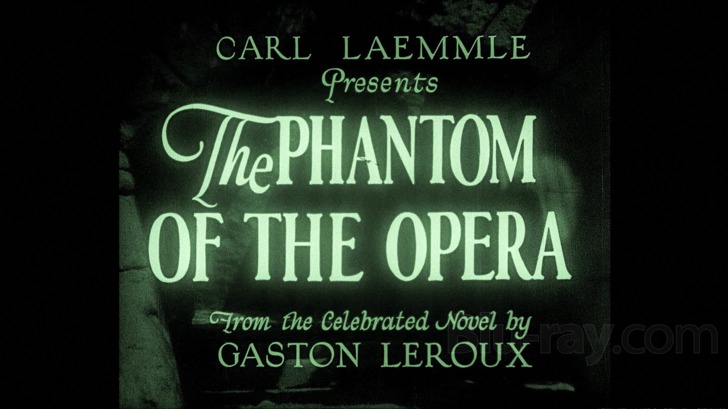
For an assessment of the film itself, please refer to my original The Phantom of the Opera Blu-ray review of the Image release.
Aside from any differences in video and audio quality and supplemental features, the major differences between the two versions which some consumers at least may consider "upgrades" include:
- 20 fps version presented in 1080p
- 1925 version presented in (upscaled) 1080i
- Excerpts from the 1930 sound version
The Phantom of the Opera Blu-ray Movie, Video Quality 
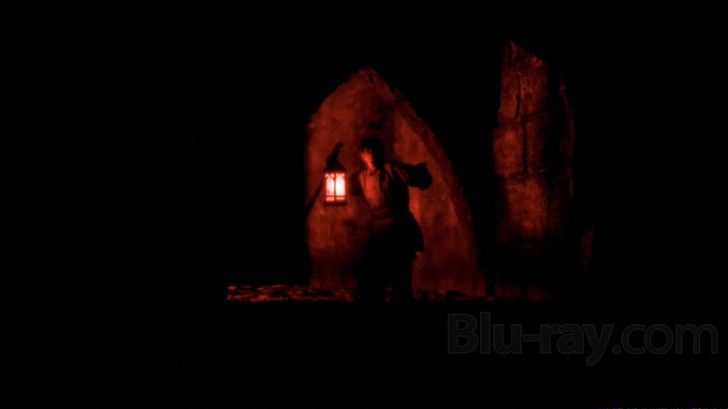
The Phantom of the Opera is presented on Blu-ray by Kino Lorber with an AVC codec. Both the 24 fps and 20 fps versions are presented
in 1080p in a somewhat variable aspect ratio that hovers around 1.29:1 (note, for example, the slightly wider aspect ratio on the Technicolor
screenshot of the Red Death, which were sourced from a different element than the bulk of this transfer). The 1925 version is presented in 1080i
at 1.33:1. For an assessment that is generally in line with what is
seen on this release, please refer to the video section of my original The Phantom of the Opera Blu-ray review. The biggest difference in video quality here is with regard to the 20 fps
version, which is at least marginally clearer and more stable looking on this release, which is also not to suggest that it's going to knock anyone's
socks off. There's incrementally less damage on display, but still such regular knicking, scratching and actual nitrate decay that some may find the
difference negligible. While the 1925 version would perhaps seem to have benefited from its upgrade to 1080i, the image quality is surprisingly
less dramatically improved from the Image release than some might expect (or at least hope). The 1925 version is still a pretty fuzzy, ill defined
looking version, though of course retains an ineluctable historical importance. I've upped the video score of this release from my 3.5 score for the
Image release in order to indicate some improvement, though I'd probably rate this closer to 3.75 if I were able to in order to indicate the
improvement, while noticeable, is not at earth shattering levels.
Note: I have followed the screenshot format of my original The Phantom of the Opera Blu-ray review, with screenshots 1-10 coming from the 24 fps version, screenshots 11-15
from the 20 fps version and screenshots 16-19 from the 1925 version. I've done my best to duplicate, or at least approximate, the screenshots
between the various versions (and releases) to maximize the ability to compare easily by toggling between full sized windows.
The Phantom of the Opera Blu-ray Movie, Audio Quality 
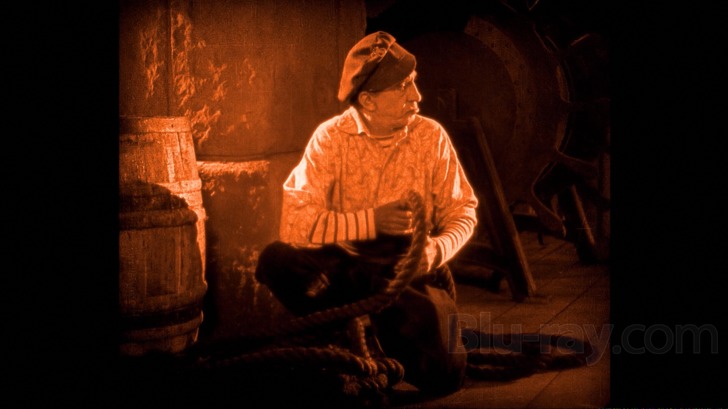
While the Kino Lorber release offers the same basic soundtracks as those discussed in my original The Phantom of the Opera Blu-ray review (which I refer you to for a general assessment of the sound of the various scores), it provides the tracks in stereo, unlike the first Image Blu-ray release. There are still occasional (relatively minor) sync issues at play, perhaps most noticeably with the Gaylord organ score, though I don't think anything is "dramatic" enough that it will cause a lot of concern. Fidelity is excellent across all the tracks and there is certainly a very wide variety of styles for listeners to take in on repeated viewings/listenings.
The Phantom of the Opera Blu-ray Movie, Special Features and Extras 
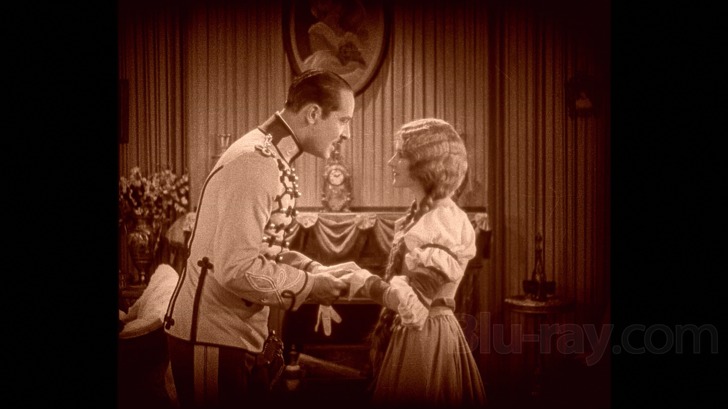
Disc One:
- 24 fps Version (1080p; 1:18:15)
- 20 fps Version (1080p; 1:32:09)
- Commentary by Dr. Jon Mirsalis is the same interesting commentary discussed in the Supplements section of my previous The Phantom of the Opera Blu-ray review.
- 1925 Version (1080i; 1:54:18)
- Excerpts of the Sound Version (1080p; 53:55) contains this explanatory preface:
In 1930, Universal re-released The Phantom of the Opera with a synchronized sound-on-disc track of music, effects, and newly filmed dialogue scenes. While the audio survives today, only one nine minute reel of the picture element is known to exist. The following is a generous sampling of the 1930 audio. It has been synchronized to the standard 1929 release version when appropriate. The surviving reel of picture is presented in its entirety.
The soundtrack is pretty ragged sounding and serves mostly as a curiosity here, probably one reason this version is considered a supplement. - Original Screenplay (1080p; 1:31:00) scrolls upward rather quickly, so have the pause button on your remote handy.
- Original Theatrical Trailer (1080p; 3:14)
- Gabriel Thibideau Interview (1080i; 10:30)
- Burton Holmes Travel Pictures:
- Paris from a Motor (1080p; 3:24)
- A Trip on the Seine (1080p; 3:30)
The Phantom of the Opera Blu-ray Movie, Overall Score and Recommendation 
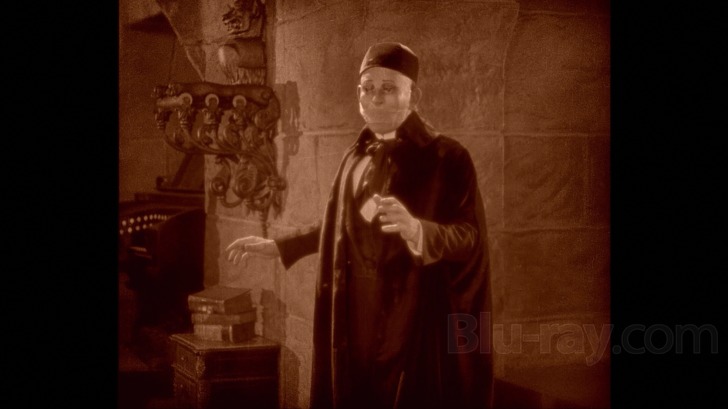
With so many choices of this iconic film available (I haven't really even mentioned the British Blu-ray from BFI), consumers may feel like they need a flowchart in order to discern the differences between them all. The bottom line here is that this release at least largely repeats the Image Blu-ray release, with some improvements to both video and audio, but with a few minor anomalies still attending. This release's one big calling card, however much of a curiosity it may be, is the inclusion of a large swath of the 1930 sound version, which for Phantom rabid completists, will probably be enough to entice yet another trip to the Paris sewer wells. Highly recommended.
Other editions
The Phantom of the Opera: Other Editions

The Phantom of the Opera
1925 version plus two 1929 reissue restored versions
1925

The Phantom of the Opera
1925
Similar titles
Similar titles you might also like

The Hunchback of Notre Dame
1923

Baron Blood
Gli orrori del castello di Norimberga
1972

Fright Night 2: New Blood
2013

Mad Love
Warner Archive Collection
1935

The Lodgers
2017

Son of Frankenstein
1939

The Wolf Man 4K
1941

The Eyes of My Mother
2016

Mr. Sardonicus
1961

Son of Dracula 4K
1943

Frankenstein 4K
1931

The Nightcomers
1971

The Crimson Cult
Curse of the Crimson Altar
1968

The Bride of Frankenstein 4K
1935

Hell Night
Collector's Edition
1981

Gwen
2018

Marrowbone
The Secret of Marrowbone
2017

Tales of Halloween
2015

The Disappointments Room
2015

Kiss of the Damned
2012